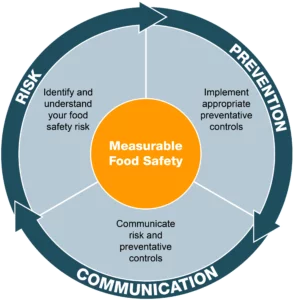
/SPONSORED CONTENT/
Almost all foods that are produced, served, and sold have a level of risk that if not handled properly may lead to a product potentially becoming unsafe. As food safety professionals it is our responsibility to design and manage food safety programs that identify and reduce these risks. Managing and measuring food safety in the 21st century takes an understanding of what the risks are, how to prevent them and how to communicate the concepts and procedures within our food safety programs.

Risk:
According to the World Health Organization (WHO) it is estimated that 600 Million people (1 in 10) suffer annually from a foodborne illness and 420,000 of those die as a result. Even though only a small fraction of the billions of meals consumed annually lead to foodborne illness, there is still a public health need to make food safer. Research in this area has and continues to provide data-driven understanding of what the specific risks are and how to control them. While there will never be zero risk, we need to drive towards that as much as possible while knowing the difference between real risk and perceived risk.
Collecting and analyzing information like temperature logs or audit results from the food manufacturing and foodservice industry is one tool that academia is using to leverage data to better differentiate between real and perceived food safety risks. Another part of this process is to look at actual foodborne illness statistics provided by the morbidity and mortality weekly report (MMWR) published by CDC weekly. This report helps us understand which risk factors to focus on and how these risks change over time. These measurements are key pieces of data that provide academics and researchers with a more holistic view that can better identify where to focus more research. Whole genome sequencing is one example of how data is playing an even greater role in understanding and identifying illnesses and where they are coming from. This technology enables researchers and investigators to identify small illness clusters that may have gone undetected in the past.
Technology is providing the ability to analyze these daily measurements to help understand how to identify deficiencies faster and more accurately, which provides opportunities to identify new efficiencies.
Prevention:
Monitoring and controlling food safety hazards can be onerous particularly in fast paced production environments like foodservice and retail, and successful management of these hazards requires robust controls. Paper based systems are one solution but like in every area of business, technology can be leveraged as a viable alternative to paper.
Technology systems comprised of advanced stationary and handheld devices, commonly referred to as Digital Food Safety Management (DFSM) systems can supplement and or replace a paper-based food safety program. A DFSM system operates behind the scenes by continuously monitoring and analyzing the actual execution of key food safety risk control processes (for example, pasteurization, cooking, cooling, storage) that you define and program into the system. With this in place the DFSM system can provide real-time alerts via email and/or text message to appropriate employees of potential unsafe conditions that require action. This can enable a more efficient process of identifying, investigating, and preventing potential food safety hazards in near real-time. One immediate benefit is the time given back to valuable employees that document storage area temperatures. Depending on the size and complexity of an operation this can range from 2-4 hours a day that is able to be reallocated somewhere else. In addition, the DFSM system provides monitoring of these areas around the clock. So, if a door was accidentally left ajar or there is an unexpected interruption in power, the stationary temperature monitoring sensors continue to operate and will alert you to potentially hazardous conditions. This can translate into avoiding large amounts of unnecessary food waste and inventory.
Communication:
It goes without saying that 2020 was a year like none other that critically impacted the retail and foodservice industry. The U.S. restaurant industry losses alone are estimated to be $240 Billion according to the most recently published National Restaurant Association’s State of the Industry report. Re-establishing consumer confidence in the industry is paramount, and the need to quickly adapt to changing health and safety requirements is no longer just a nice to have, it is an absolute business necessity. The need for efficient and effective communication has never played a more important role in the retail and restaurant industry. As new regulatory requirements around food and guest safety are released, organizations need to quickly respond to maintain consumer expectations. This includes updating policies and procedures, training materials and getting the new information out to the field and into practice.
DFSM systems provide an ideal environment for communicating program updates through use of user-friendly programmable workflow processes. An organization using a DFSM system can also leverage these metrics and provide data driven messaging to consumers that communicates how employee and consumer health and safety.
Looking Forward:
Food safety professionals have spent countless hours over the last twenty plus years identifying food-related risks, ways to control those risks and record keeping processes to document them. Real-time operational visibility into actual execution of these processes has been a missing ingredient that has allowed unnecessary foodborne illnesses to continue to occur. Digital Food Safety Management systems are positioned to fill this critical gap which is good for business, but more importantly good for consumers and public health. The time has come for industry to step out of the past and embrace technology’s ability to work smarter.
Learn more about DFSM systems by visiting our website.

Eric Moore
Director of Food Safety and Industry Outreach
Testo North America